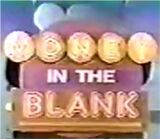| Host | |
| Kevin O'Connell | |
| Announcer | |
| Johnny Gilbert | |
| Broadcast | |
| Unsold Pilot for CBS: 7/26/1987 | |
| Packager | |
| Bob Stewart Productions | |
Hello, I'm Teresa Ganzel and "I wish I could fall in _____ with a rich _____!" Hi, I'm Nathan Cook, what Teresa meant to say is, "I wish I could fall in LOVE with a rich MAN!". I guess that leaves me out. (audience laughter) From Television City in Hollywood, this is MONEY IN THE BLANK! With your host, KEVIN O'CONNELL!
Money in the Blank features two teams of two (consisting of one celebrity and one contestant) play a game where a phrase with two or more words missing is given and they have to fill in the blanks with missing words of their own to help the team partners to guess a mystery subject.
The bonus round is nearly identical to the game show Three on a Match.
Gameplay
Main Game
In the main game, two givers were a shown a word, phrase or a name, followed by a sentence with a few blanks in it. The first giver to buzz-in had a chance to complete the sentence with his/her own clue words to get his/her partner to say the answer. The team in control had eight seconds to complete the phrase and give the answer; doing so successfully earned points. The buzz-in team scored 20 points for completing the task, but if they fail by running out of time, giving a wrong answer, having the giver give away the answer or if the giver did not say the sentence exactly as it appeared, the opposing team had a chance to steal for 10 points more or 30 points.
The celebrities gave the clues in the first half of the game, but as soon as a team got at least 80 points the roles were switched, making the contestants give the clues.
The first team to reach 150 points wins the game, $500 for the civilian contestant, and a chance to face the "Familiar Phrases" bonus board.
Bonus Game (Familiar Phrases)
The "Familiar Phrases" bonus board heavily resembles the Three on a Match game board. Behind the 12 boxes were four three-word phrases. The left column (worth 10 points each) had the first words, the center (worth 20 points each) had the second words, and the column on the right (worth 40 points each) had the third words. What made this round interesting was that no phrases were read across; they were always randomized.
The winning team used their winning score of 150 points to buy as many of the boxes as they could, taking turns picking by point value and colored row (red, blue, yellow, and green). After finding a three-word phrase, that part of the bonus stopped there and the contestant then played the second half.
Behind the words were dollar amounts ranging from $1,000 to $10,000. The contestant had up to three picks: on the first two, if the money shown is to the player's liking, s/he may keep it or throw the money back and pick another word at the risk of getting a lower dollar amount; on the third pick, whatever money revealed was the contestant's to keep.
In the first half, finding the familiar phrase on the first three picks awarded $15,000.
Trivia
The set used in this pilot was later used on another pilot called Eye Q.
Studio
CBS Television City, Hollywood, California

